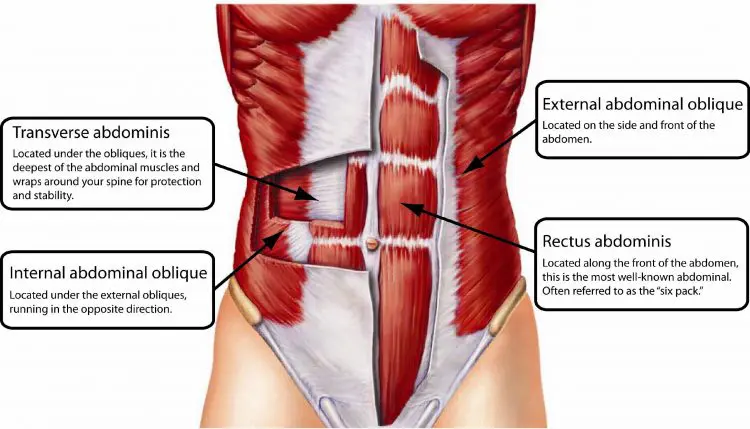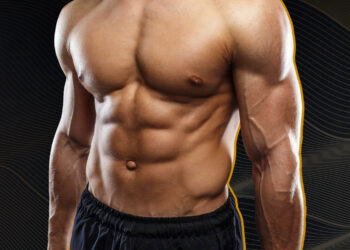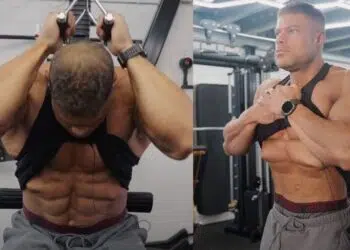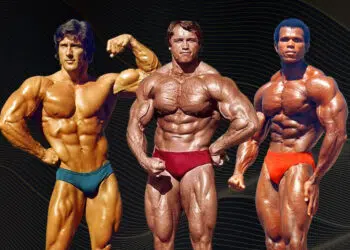Abs are an important muscle group, and if you want to develop them fully, you must train them correctly. That means working them with plenty of volume and intensity and hitting them from various angles. Such an approach is time-consuming, which is why training your abs at the end of your workout may not be ideal.
One way around this problem is to stop training your abs at the gym and work on them at home. That way, you’ll have all the time and energy you need to get a great abs workout.
You may wonder how you’ll train your abs without gym equipment. After all, what’s better than cable crunches, machine crunches, and cable Pallof presses?
With over 35 years of experience sculpting washboard abs for my clients, I’ve discovered the 15 most effective ab exercises you can do anytime, anywhere. In this article, I’m sharing my personal trainer secrets to help you achieve the strong, defined core you’ve always wanted.
Recent Updates: On June 18, 2024, Fitness Volt’s Content Strategist Tom Miller (CSCS) and Senior Editor Vidur Saini (American Council on Exercise-CPT) updated the article and added actionable expert tips throughout the piece to improve the reader experience. Level Up Your Fitness: Join our 💪 strong community in Fitness Volt Newsletter. Get daily inspiration, expert-backed workouts, nutrition tips, the latest in strength sports, and the support you need to reach your goals. Subscribe for free!
15 Ab Exercises You Can Do Anywhere and Anytime
Save gym time and get a better core workout by training your abs at home. Here are 15 of the best abs exercises you can do anywhere and anytime:
- RKC Plank
- Hollow Holds
- Hollow Rocks
- Bear Crawl
- Walkouts
- High Birddog
- Bench Plank Mountain Climber
- Alternating Leg Lowers
- Side Planks
- Lying Windshield Wipers
- Side Jackknife
- Oblique Crunch
- Butt-Ups
- Flutter Kicks
- Bicycle Crunch
1. RKC Plank
| Sets & Reps | Target Muscles |
| 3 x 30-60s | Rectus abdominis, transverse abdominis, obliques, serratus anterior, erector spinae |
Forget holding a plank for several minutes. Try the ultra-intense Russian Kettlebell Challenge (RKC) plank instead.
With this variation, rather than planking for as long as possible, you tense your muscles as hard as possible and exhaust them in 10-20 seconds. This is not just more time-efficient but also builds real-world core strength.
“To further engage your serratus anterior, imagine pushing your forearms through the floor while pulling your shoulder blades apart,” says Saini.
Pro Tip: Maintain a packed shoulder position by actively pulling your forearms towards your toes, engaging your lats, and preventing shoulder protraction.
| Difficulty | Progression | Regression |
| Beginner | Weighted variation | Knees on the ground |
Learn how to do the RKC plank here.
2. Hollow Holds
| Sets & Reps | Target Muscles |
| 3 x 30-60s | Rectus abdominis, transverse abdominis, obliques, hip flexors |
Hollow holds are a sort of supine (upward-facing) plank. However, it’s considerably more challenging because you need to support your legs and upper body. Hollow holds are a gymnastic conditioning exercise that’s also popular in CrossFit.
Saini suggests creating tension throughout your entire body, from your fingertips to your toes, to maintain a rigid and stable position.
How to do it:
- Lie on your back and extend your arms overhead so your biceps are next to your ears. Straighten your legs and point your toes, knees, and feet pressed together.
- Brace your core by drawing your ribs toward your pelvis and flexing your abs. Inhale and draw air down into your abdomen. You should feel your entire midsection solidify and become rigid.
- Lift your feet, legs, shoulders, and arms off the floor and press your lower back into the ground. The only point of contact should be your lumbar spine region, which is roughly the lower third of your spine, from the tailbone to the mid-back area. Look down your body to your feet; do not tuck your chin into your chest.
- Hold for just a few seconds and then relax, working up to longer holds as you get stronger.
Pro Tip: Visualize hollowing out your stomach by drawing your belly button towards your spine, creating maximal tension in your core.
| Difficulty | Progression | Regression |
| Beginner | Increase hold time | Planks |
3. Hollow Rocks
| Sets & Reps | Target Muscles |
| 3 x 10-15 reps | Rectus abdominis, transverse abdominis, obliques, hip flexors |
If you’ve mastered hollow holds, you are probably ready for hollow rocks. With this variation, you transfer your weight up and down your spine by rocking. This shifts the load to different parts of your core, creating a more challenging, dynamic exercise.
Focus on keeping your lower back glued to the floor throughout the entire movement to prevent unnecessary strain and maintain proper form, cues Saini.
How to do it:
- Lie on your back with your arms above your head, biceps next to your ears, and legs straight. Point your toes and squeeze your legs together.
- Brace your abs and push your lower back into the floor. Lift your legs and shoulders/arms a few inches off the floor.
- Without changing the angle of your arms or legs, rock gently while maintaining core stability. Remember to breathe; no breath-holding, please!
Pro Tip: Initiate the rocking motion from your hips, not your shoulders, to maintain core engagement and avoid excessive momentum.
| Difficulty | Progression | Regression |
| Intermediate | Increase range of motion | Hollow holds |
4. Bear Crawl
| Sets & Reps | Target Muscles |
| 3 x 20-30m | Shoulders, chest, triceps, core, quadriceps, hamstrings |
The bear crawl is basically a moving plank. Transferring your weight from limb to limb as you move forward increases core engagement while also working your arms and legs. With so many muscles involved, this full-body exercise is also great for building fitness and endurance.
Saini recommends spicing up your workouts by incorporating lateral movements, backward crawls, and even rotating your body for a greater challenge.
How to do it:
- Kneel down on all fours so your hands are directly under your shoulders and your knees are under your hips. Pull your toes up and press the balls of your feet into the floor.
- Brace your abs, pull your shoulders down and back, and rotate your elbows inward to engage your lats. Your lower back and neck should be neutral. Lift your knees a few inches off the floor while keeping your hips level with your shoulders.
- Without lifting your hips, move your left hand and right foot forward, and then your right hand and left foot.
- Continue crawling forward over the specified distance or number of steps.
- You can also bear crawl backward, sideways, and diagonally.
Pro Tip: Focus on maintaining a neutral spine and keeping your hips low to maximize core activation and minimize lower back strain.
| Difficulty | Progression | Regression |
| Beginner | Add resistance band around thighs | Up and down plank |
5. Walkouts
| Sets & Reps | Target Muscles |
| 3 x 8-12 reps | Hamstrings, glutes, core, shoulders, lats |
Walkouts involve moving from standing to an extended plank position for reps. As such, it’s an excellent core and abs exercise that also works your arms, shoulders, and chest. Also, performed with straight legs, walkouts could help improve hip and hamstring mobility.
“Experiment with hand placement by gradually widening your stance to target different muscle groups and increase the difficulty,” says Saini.
How to do it:
- Stand with your feet together and your arms by your sides. Brace your abs and pull your shoulders down and back. Bend your knees slightly.
- Hinging forward from your hips, place your hands on the floor in front of your feet. Bend your knees as much as necessary to do this.
- Keeping your abs tight, walk your hands forward and into the push-up position. Walk your hands a little further forward to make this exercise more challenging.
- Walk your hands back toward your feet and then stand up.
- That’s one rep – keep going!
Pro Tip: At the bottom of the walkout, engage your glutes and hamstrings to initiate the return movement, powering back up to standing.
| Difficulty | Progression | Regression |
| Beginner | Walkout to a push-up, add a clap at the top | Planks |
6. High Birddog
| Sets & Reps | Target Muscles |
| 3 x 8-12 reps | Core, glutes, shoulders, back |
Birddogs are usually done while kneeling. That’s a decent option for beginners but not usually intense enough for more advanced exercisers. The high Birddog is a much more challenging exercise that should provide your abs with a far more intense workout.
Saini recommends engaging your pelvic floor muscles as you lift your arm and leg to increase stability and protect your spine.
How to do it:
- Adopt the push-up or high plank position with your arms, legs, and body straight. Brace your core.
- Without twisting your shoulders or hips, lift your left hand and right foot so they are roughly parallel to the ground. Hold this position for 3-5 seconds.
- Lower your limbs and then repeat on the opposite side.
- Continue alternating sides for the duration of your set.
- Make this exercise harder by moving your arms forward to extend your base of support.
Pro Tip: Extend your raised arm and leg simultaneously, creating a long line from fingertips to heel while maintaining a stable core.
| Difficulty | Progression | Regression |
| Beginner | Weighted variation | Conventional Birddog |
7. Bench Plank Mountain Climber
| Sets & Reps | Target Muscles |
| 3 x 15-20 reps | Core, shoulders, triceps, hip flexors, quads |
The bench plank mountain climber involves moving your legs while stabilizing your core. This increases midsection muscle engagement to produce a more challenging workout. Rest your forearms on a weight training bench or sturdy chair. You can also do this exercise in the high plank position, i.e., with straight arms.
For people who want to make this exercise more challenging, Saini suggests removing one hand from the bench and performing single-arm mountain climbers to test your balance and coordination.
How to do it:
- Place your forearms on an exercise bench and walk your feet out and back into the plank position. Brace your abs.
- Bend one leg and pull your knee up and into your elbow/the edge of the bench.
- Extend your leg, swap sides, and repeat.
- Continue alternating legs for the allotted duration.
Pro Tip: As you drive your knee towards your chest, simultaneously tuck your pelvis to engage your lower abdominals and create a posterior pelvic tilt.
| Difficulty | Progression | Regression |
| Intermediate | Increase speed, add a push-up after each rep | Perform on the floor |
8. Alternating Leg Lowers
| Sets & Reps | Target Muscles |
| 3 x 15-20 reps | Lower abdominals, hip flexors |
Double leg raises are a popular old-school abs exercise. However, it’s tough to do them without letting your lower back lift off the floor. The resulting lumbar spine hyperextension makes the exercise less effective and could result in back injury. Moving one leg at a time is a much safer option and increases oblique muscle activation as an added benefit.
“Instead of lowering your legs straight down, try lowering them diagonally to each side to target your obliques along with your lower abdominals,” cues Saini.
How to do it:
- Lie on your back with your arms extended straight at your sides.
- Brace your abs and lift your legs until your feet are over your hips and your knees are relatively straight.
- Keeping your left leg stationary, lower your right leg down until your heel lightly touches the floor. Keep your lower back pressed flat.
- Return to the starting position and repeat with your left leg.
- Alternate legs for the duration of your set.
Pro Tip: Place your hands under your hips for leverage.
| Difficulty | Progression | Regression |
| Beginner | Slow down the movement, pause at the bottom | Bend knees slightly |
9. Side Planks
| Sets & Reps | Target Muscles |
| 3 x 30-60s | Obliques, quadratus lumborum |
While regular and RKC planks work your entire core, they primarily emphasize your rectus abdominis. Switching to side planks provides more work for your obliques. As the obliques are as important as your abs for appearance and function, including them in your abs workouts is important.
Level Up Your Fitness: Join our 💪 strong community in Fitness Volt Newsletter. Get daily inspiration, expert-backed workouts, nutrition tips, the latest in strength sports, and the support you need to reach your goals. Subscribe for free!
Saini advises bracing your core as hard as possible throughout the exercise for maximum target muscle stimulation.
How to do it:
- Lie on your side and rest on your elbow. Your body and legs should be straight. Brace your abs.
- Lift your hips up so your shoulders, hips, and feet form a straight line. Tense your entire core as hard as you can.
- Hold for as long as possible, then relax and swap sides.
- Make this exercise harder by lifting your uppermost leg.
Pro Tip: Stack your feet for added stability, and actively reach your top arm towards the ceiling to create a longer lever and increase the intensity.
| Difficulty | Progression | Regression |
| Beginner | Lift top leg, increase hold time | Conventional plank |
10. Lying Windshield Wipers
| Sets & Reps | Target Muscles |
| 3 x 10-15 reps | Obliques, lower abdominals |
Lying windshield wipers are a challenging core exercise that specifically targets your obliques. It’s a great home alternative to cable Pallof presses and cable woodchops. Be warned; this exercise is more strenuous than it looks!
Saini suggests varying the speed of your leg movements, alternating between slow and controlled movements and faster, more dynamic ones.
How to do it:
- Lie on your back with your legs straight and arms extended out to your sides. Brace your core and lift your legs, so they’re vertical.
- Using your arms for balance, rotate your hips and lower your legs down to the side until they’re just above the floor and close to your outstretched hand.
- Return to the starting position and then repeat to the other side.
Pro Tip: To protect your lower back, initiate the movement from your obliques and avoid using momentum by controlling the descent and ascent of your legs.
| Difficulty | Progression | Regression |
| Intermediate | Straight legs, touch the floor with toes | Bent knees, smaller range of motion |
11. Side Jackknife
| Sets & Reps | Target Muscles |
| 3 x 10-15 reps | Obliques, hip flexors, transverse abdominis |
The side jackknife is another excellent bodyweight core and oblique exercise. It’s a very spine-friendly exercise that is ideal for home workouts as all you need to do it is a foam mat or folded towel to lie on.
Saini recommends performing this exercise in a high-side plank position for a more intense oblique pump.
How to do it:
- Lie on your side with your body straight. Your hips and shoulders should be stacked, i.e., vertical, and not leaning forward or back.
- Place your uppermost hand on your temple and push your elbow back to open your chest.
- Extend your lowermost arm out in front of you for balance.
- Contract your obliques, brace your abs, and lift your shoulders off the floor. Simultaneously lift your top leg. Hinge at the waist like a folding jackknife.
- Lie back down and repeat.
- Do the same number of reps on both sides.
Pro Tip: Exhale as you contract your obliques and bring your knee towards your elbow, emphasizing the mind-muscle connection.
| Difficulty | Progression | Regression |
| Intermediate | Add ankle weights | Lying leg raises |
12. Oblique Crunch
| Sets & Reps | Target Muscles |
| 3 x 15-20 reps | Obliques |
Oblique crunches are a lot like side jackknives. However, you don’t move your legs and must focus solely on lifting your upper body. If you find it hard to coordinate moving your legs and upper body simultaneously, you’ll probably appreciate the simplicity of this exercise.
Saini advises avoiding crunching your neck as you lift your shoulders off the ground to prevent neck strain.
How to do it:
- Lie on your left side with your hips square and your legs bent. Place your left hand on the right side of your waist to provide feedback from your working muscles. Put your right hand on the side of your head.
- Use your uppermost abs and obliques to flex your torso and draw your right shoulder down toward your hip. Move slowly and deliberately, contracting your obliques as hard as you can.
- Pause at the top of each rep for 2-3 seconds, lie back down, and repeat.
- Roll over and do the same number of reps on the opposite side.
Pro Tip: Focus on a slow, controlled movement to maximize oblique muscle engagement.
| Difficulty | Progression | Regression |
| Beginner | Hold weight behind the head | Conventional crunches |
13. Butt-ups
| Sets & Reps | Target Muscles |
| 3 sets to failure | Lower abdominals |
With no bar to hang from and no captain’s chair to use, you may be wondering how you will do hanging knee and leg lifts at home. The good news is that you can work the same muscles with butt-ups. This might not be the most challenging abs exercise, but it can be effective if you leave it to the end of your workout when your muscles are tired.
How to do it:
- Lie on your back. Brace your abs and raise your legs, so they are straight and vertical. Press your lower back into the floor. Put your arms on the floor by your sides for balance. Rest your head on the floor to relax your neck.
- Without using your arms, lift your butt off the floor and push your feet up toward the ceiling. Try to keep your legs vertical, as moving them toward your head will make this exercise easier.
- Without dropping your legs, lower your butt back down to the floor and repeat.
- Increase abs engagement by exhaling forcefully as you lift your butt and inhaling as you lower.
Pro Tip: Squeeze your glutes at the top for maximal activation.
| Difficulty | Progression | Regression |
| Advanced | L-sit, hanging leg raise | Lying leg raise |
14. Flutter Kicks
| Sets & Reps | Target Muscles |
| 3 x 30-60s | Hip flexors, lower abdominals |
Flutter kicks are a popular exercise in the military, especially with the Navy SEALs. They involve bracing your abs to stabilize your spine while you move your legs. Done for reps or time, this is a demanding ab exercise you can do anywhere and anytime.
“Keep your core braced throughout the exercise to get the best bang for your buck,” says Saini.
How to do it:
- Lie on the floor with your legs straight. Put your hands flat on the floor under your butt. Brace your abs.
- Lift your head and shoulders a few inches off the floor and lift your legs by roughly the same amount. Push your lower back into the floor and brace your abs.
- Without letting your lower back arch, kick your feet up and down using an alternating leg action. Four kicks equal one rep.
Pro Tip: Place a small towel or cushion under your tailbone to maintain a neutral spine and reduce pressure on your lower back.
| Difficulty | Progression | Regression |
| Beginner | Increase duration, lift head and shoulders higher | Leg raises |
Read more about flutter kicks, including some great tips, alternatives, and variations, in this in-depth guide.
15. Bicycle Crunch
| Sets & Reps | Target Muscles |
| 3 x 15-20 reps | Rectus abdominis, obliques |
Are you looking for an exercise that trains your abs and obliques simultaneously? Look no further than bicycle crunches. This is a great exercise if you want to work your entire core but don’t have much time to spare.
Saini suggests touching your elbow to the outside of your thigh to increase the stretch on your obliques instead of touching your elbow to your opposite knee.
How to do it:
- Lie on your back with your legs straight. Place your hands on your temples, brace your abs, and lift your feet a few inches off the floor. Press your lower back into the floor.
- Bend one leg and pull your knee in toward you. Simultaneously, lift your head and shoulders, twist your upper body, and touch your opposite elbow to your bent knee.
- Return to the starting position and repeat on the other side.
- Continue alternating legs for the duration of your set.
- You can also do this exercise with your straight leg resting on the floor, which is considerably easier.
Pro Tip: Maintain a consistent pace and avoid rushing through the reps. Focus on the contraction of your obliques with each twist, ensuring a full range of motion.
| Difficulty | Progression | Regression |
| Beginner | Hold each contraction | Hanging leg raises |
Best Ab Workout For a Ripped Six-Pack
Perform this workout at least twice weekly for the best results:
| Exercise | Sets | Reps | Rest |
| RKC Plank | 3 | 30 seconds | 60 seconds |
| Walkouts | 3 | 8-12 | 60 seconds |
| High Birddog | 3 | 8-12 | 60 seconds |
| Alternating Leg Lowers | 3 | 15-20 | 30 seconds |
| Bicycle Crunch | 3 | 15-20 | 30 seconds |
Abs Anatomy 101
You don’t need an intimate knowledge of anatomy and physiology to train your abs. That said, knowing just a little about the muscles that make up your midsection can be helpful. For starters, it will make choosing the best exercises for your abs workouts a whole lot easier.
The first thing to understand is that while the word abs is short for rectus abdominis, people often say abs when they actually mean their core. Core is the collective term for all the muscles that make up your midsection.

While the rectus abdominis IS an important muscle, it works with all the other core muscles, and they’re all necessary for appearance and function.
The main muscles that make up your core are:
Rectus abdominis
Your abs are responsible for flexing your spine. It can pull your sternum down toward your pelvis or lift your pelvis up toward your sternum. There is no such thing as upper or lower abs, but these two different movements make it feel like there are.
Your abs are also split down the middle by a fibrous band of tissue called the linea alba, which literally means white line. Because of this separation, you can contract one side of your rectus abdominus at a time. Subsequently, your abs are also involved in lateral flexion of your spine. This means they bend you sideways as well as forward.
Internal and external obliques
The obliques are located on either side of your rectus abdominis. In a way, they “frame” your abs. There are two different oblique muscles; the internal and external obliques. The external obliques are the largest of the core muscles, while the internal obliques are smaller and located underneath.
The obliques are responsible for the rotation and lateral flexion of your spine. In other words, they turn and bend your spine from side to side.
Transverse abdominis
This hidden muscle is potentially your most important core muscle. You can’t see it, but you’ll definitely feel it working. Known as TVA for short, your transverse abdominis is a deep abdominal muscle that encircles your abdomen like a weightlifting belt.
When contracted, your TVA compresses your abdominal contents to create intra-abdominal pressure or IAP. IAP stabilizes your spine and pelvis from within.
Bracing activates your TVA. To brace, you pull up your pelvic floor like you were trying to stop the flow of urine, contract (but don’t pull in) your abs like you were about to get punched in the gut and inhale. If you’ve done it right, you should feel your entire midsection solidify and feel strong.
You should brace any time you lift anything heavy and bracing will increase core muscle activation during your abs workout too.
Related: How Many Abs Can You Have? 4-Pack vs 6-Pack vs 8-Pack
More Abs Exercises:
- The 10 Most Awesome Upper Abs Exercises
- 15 Best Cable Exercises for Abs
- 10 Barbell Exercises For Abs
- Do Squats Work Your Abs?
- 7 Ways to Do Rollouts When You Don’t Have an Abs Wheel
- Best Abs Exercises to Build Core Strength for CrossFit
- Planking It! Five Minute Plank Workout for Shredded Abs
Wrapping Up
There are hundreds of abs exercises to choose from, but some are better than others. While crunches and sit-ups are okay, they’re not the most exciting exercises, and if you do them too often, they’ll start to lose their potency. Plus, after doing them for a few weeks, you’ll probably be able to crank out a whole lot of reps, and that’s not a good use of your training time.
With 15 alternative exercises to choose from, you have everything you need to train your abs without equipment and in the comfort of your own home.
Finally, remember that if you want to see your abs, you may need to drop some fat and get ripped. After all, it doesn’t matter how sculpted your abs are; if they’re covered in a layer of fat, they’ll be invisible!
Interested in measuring your progress? Check out our strength standards for Machine Seated Crunch, Cable Crunch, Sit Ups, and more.








